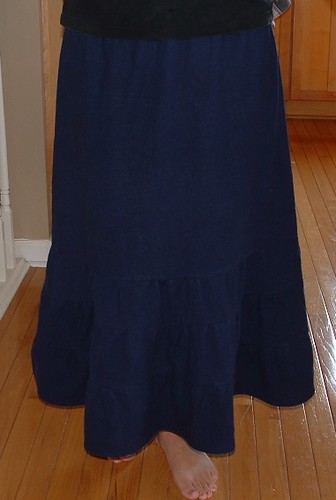
First of all you need to cut your binding strips. I used strips that were 1 7/8" wide but if it's your first time you should probably use 2 1/4" or 2 1/2" strips. You'll have to figure out how many strips you need to go all the way around your quilt with several inches to spare. You can use math, or cut the strips and physically lay them around the edge of the quilt until you have enough. I've done scrappy quilt bindings before using several different fabrics, and used the physically-laying-it-out method for those quilts.

Using the angle lines on your ruler or mat, cut the ends of the strips to a 45 degree angle.

Cut both ends the same way so the strips are very long parallelograms.

To get them ready to piece together, set two strips next to each other.

Then, flip one over on top of the other so the edges line up for sewing. You will sew a 1/4" seam, so they need to line up 1/4" in from the edge. Pin it.

Sew it. Sew all the strips together this way. The diagonal seam here helps spread out the bulk of the seam, since you'll be folding the binding strip over itself a couple times.

Go to the ironing board; press the binding seams. I press to one side, you can press them open if you want but that's more work.

Now press the entire binding strip in half the long way.

Next, find the end of your binding strip. If your parallelogram went the opposite way from mine, cut the corner off so it points the way mine does in this picture. Press the short edge in 1/4".

Fold it in half lengthwise and press this end again.

You can't really see it in this picture, but I'm leaving it anyway. Lay out the binding around the quilt, with the end you just fiddled with in the middle of one of the sides. Check the seams on the binding to make sure there aren't any of them on the corners of the quilt. If there are, adjust your starting position. Pin the binding in place at the starting position and go to your machine.

For the entire perimeter of the quilt, you need to match up the binding and quilt edge and sew 1/4" in from that edge. I leave the extra backing and batting until after the binding is sewn on. To begin, you will be making a little slot to put the end of the binding in when you get back to your starting place. Open up the fold of the binding and sew down just the bottom layer for about 2 inches. Stop sewing and cut your threads.
Edited 9/2012: *For another way of finishing up the beginning and end of your binding strips (with a diagonal seam) see this blog post.*
Now fold the binding back up and start sewing both layers of the binding down, about 1 3/4 inches down from the beginning.

Sew the binding down that first side. I found that it helped if I pulled the binding a bit taut while sewing. When you get to the corner, stop sewing 1/4" from the edge of the quilt top. Backstitch and cut your threads.

Now, turn the quilt 90 degrees, and fold the binding straight up. Hold that diagonal fold with your finger.

And now, fold it down. You might want to pin.

Start sewing the next side at the edge of the fabric; stop 1/4" from the edge and do the corner thing again. Repeat until you've done all 4 corners.

When you get back around to where you started, you need to trim the end of your binding strip so it will fit in the little pocket you made at the beginning. I trimmed the end of my binding strip so about 1/2" of it went into the slot area past the angled part of the beginning of the binding. You have to look closely to see it in this photo.

Now you get to trim the quilt. For the 1 7/8" binding, I needed to cut the backing and batting right up to the edge of my binding. For wider binding strips, leave a little bit of batting beyond the edge. I have had a couple quilts in quilt shows and one of my judging sheets once explained that it's better (in official quilt world, I guess) to have the binding kind of puffy and nicely filled out than to let it be saggy, limp, and empty. In other words, I got bad marks for not having puffy binding, so learn from my mistakes.

I hand sew the binding to the back of the quilt. I use a ladder stitch, it's my main hand sewing stitch that my mom taught me when I was little. You can use whatever stitch you like. I try to sew the binding down far enough to cover the machine stitching that sewed it to the front of the quilt.

When you get to the corner, trim the seam allowance a bit more than you did on the straight edge.

(I'm left handed. If you aren't, this picture may not look quite right. I sew from the left to the right.) I try to fold the binding down on the top side of the corner, and sew it down past where the seam turns the corner.

Then, I fold the next side down and stitch it in place. I usually put a couple stitches in the binding where it folds on top of itself (the mitered corner), and then continue sewing down the next side of the binding.

All done! I hope this make sense. As always, comment or email me at vickivictoria at the google email service if you have questions or comments!
































